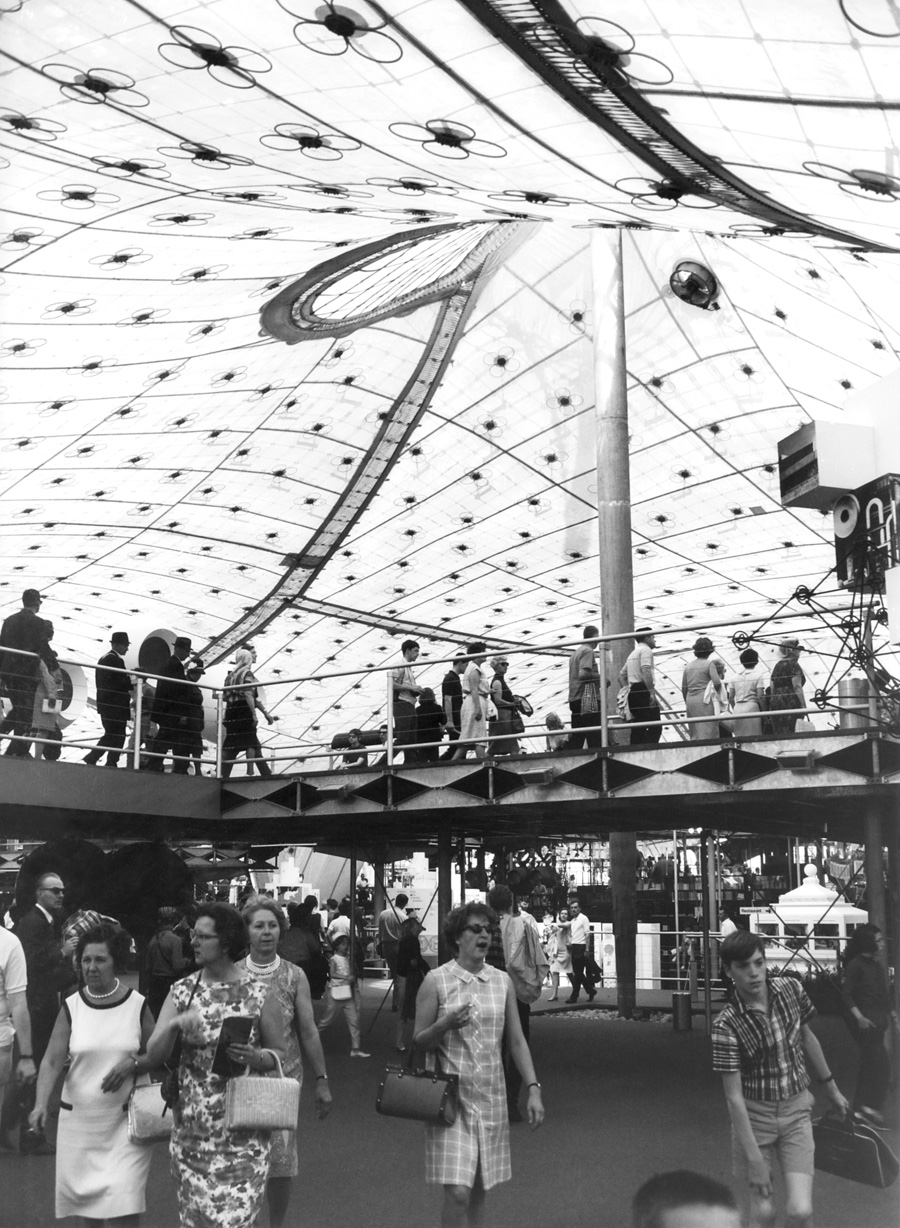-

Flyweight
West German Pavilion, Expo 67
Montreal, Canada 1967
Frei Otto, Rolf Gutbrod, Fritz Leonhardt et al.

The West German Pavilion at Expo 67, Montreal. (Photo: © Atelier Frei Otto Warmbronn) Film (no audio): footage of the development and construction of the Pavilion’s cable net structure. (Film produced by IL‚ 1981, courtesy ILEK, Stuttgart)
-
“Germany took six weeks to put up this tent, 1,200 years to put on the show inside. Come to Montreal and take a look. It’s some tent,” announces a poster for Expo 67 emblazoned with an image of the West German that pavilion Frei Otto designed for the event. A similar logic applied to the structure itself – the principles underpinning the tent concept had been years in the making; developed by Otto ever since he completed his doctorate in 1954, entitled: The Suspended Roof, Form and Structure.
Producing a truly iconic pavilion at Montreal was no small feat given the fact that neighbours at the site included Buckminster Fuller’s geodesic dome representing the United States and Moshe Safdie’s housing complex, Habitat 67. But Otto’s design eschewed the World’s Fair archetypes of the box and the sphere; instead it was a “roofscape” of such apparent lightness that it seemed on the point of taking flight.
Produced in collaboration with Otto’s friend Rolf Gutbrod, the design was intended to represent Germany’s rich heritage of industry and engineering. In fact it advanced that heritage several steps further. Making use of the “dynamic relaxation” numerical method to determine the canopy’s form, the structure’s translucent plastic skin was supported by eight steel masts and covered an area of 8,000 square metres. Underneath all that pre-stressed cable and textile membrane, visitors could view the work table used by Otto Hahn when he discovered nuclear fission in 1938, a replica of Guttenberg’s printing press and, in a nice nod to that other seminal German Expo structure, a model of Mies van der Rohe’s pavilion for the 1929 Barcelona International Exposition.
Post-Expo the tent was due to be dismantled and shipped to Germany. However, the nation it represented never got to enjoy one of the world’s first truly passive solar buildings: the pavilion passed into the ownership of the City of Montreal, who would eventually demolish the structure in 1973 to make way for – guess what – the 1976 Olympic Games. I (fs)
Expo 67 visitors inside the West German Pavilion. (Photo: © Burkhardt‚ courtesy of Atelier Frei Otto, Warmbronn)
-
Search
-
FIND PRODUCTS
PRODUCT GROUP
- Building Materials
- Building Panels
- Building technology
- Façade
- Fittings
- Heating, Cooling, Ventilation
- Interior
- Roof
- Sanitary facilities
MANUFACTURER
- 3A Composites
- Alape
- Armstrong
- Caparol
- Eternit
- FSB
- Gira
- Hagemeister
- JUNG
- Kaldewei
- Lamberts
- Leicht
- Solarlux
- Steininger Designers
- Stiebel Eltron
- Velux
- Warema
- Wilkhahn
-
Follow Us
Tumblr
New and existing Tumblr users can connect with uncube and share our visual diary.
»Architectural interpretations accepted without reflection could obscure the search for signs of a true nature and a higher order.«
Louis Isadore Kahn
Keyboard Shortcuts
- Supermenu
- Skip Articles
- Turn Pages
- Contents


